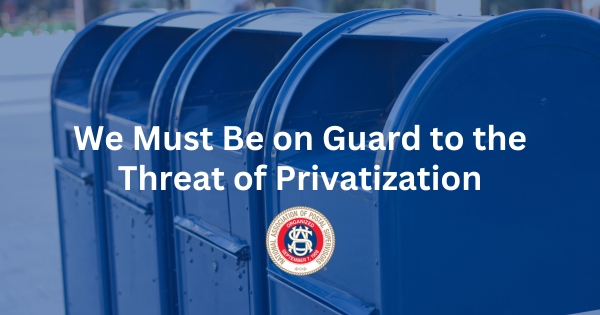We Must Be on Guard to the Threat of Privatization
We Must Be on Guard to the Threat of Privatization
By Bob Levi
NAPS Director of Legislative & Political Affairs
This column is a bit different from others you may read in this issue of The Postal Supervisor. Other columns reflect on NAPS’ success in helping repeal the financially discriminatory Windfall Elimination Provision (WEP) and Government Pension Offset (GPO), sections of the Social Security law that have impacted millions of federal, state and local government employees over the past four decades.
The 1983 amendments to the Social Security Act, which included the WEP and GPO reduction formulas, were signed into law within months of my arrival in Washington, DC. As a young congressional staff member, I lobbied vigorously for repeal almost immediately on enactment of the two provisions. So it was gratifying that I was present at the White House on Jan. 5 when the WEP and GPO finally were repealed with the stroke of President Biden’s pen.
Nevertheless, over the 40-plus years working the halls of Congress as a House staff member and, subsequently, representing Postal Service employees, I have found two of the most maddening legislative initiatives are episodic attempts to “privatize” postal operations and perpetual efforts to gut the earned benefits of dedicated public service employees, including postal employees. For the most part, the relentless grassroots campaigns conducted by the federal and postal communities have successfully derailed these ill-conceived and vindictive efforts.
However, one-party control of the Executive Branch and both houses of Congress will seriously test our collective resilience and strength. By early April, the time of the NAPS Legislative Training Seminar, the White House and Congress will have birthed their strategies to wage war on the Postal Service and slash federal and postal employee benefits. You can be sure that NAPS will be well-armed to battle harmful and punitive legislative actions against active and retired EAS postal employees and retirees.
It is important to note that postal privatization is nothing new and can take many forms; we need to be on guard. The “Delivering for America” plan’s apparent operational failures, combined with congressional frustration with Postal Service Headquarters, Oshkosh’s inability to deliver contracted postal vehicles on time, UPS reclaiming small parcel volume (i.e., SurePost), the government-cutting entity partnered by Elon Musk and Vivek Ramaswamy (DOGE) and the incoming White House’s clamor for “privatization” are poisonous.
There’s a lot to consider. I can recall former Rep. Phil Crane (R-IL) pro-posing replacing our governmental postal operation with an employee-owned organization and former Rep. Bill Green (R-NY) recommending opening and franchising residential mail receptacles to private delivery services. There also was a push for post office operations to be per formed by department stores, as well as other unwise ideas.
Clearly, these proposals were short of a wholesale governmental selloff, which also has been suggested, but they would have been harmful to universal, affordable mail service. Also, revisiting six-day and door delivery could be in the cards.
Under current law, USPS employees participate in FERS, TSP and, now, PSHB. Congress and the White House could, with the stroke of a pen, close off these benefit programs to Postal Service employees and encourage the agency to create a distinct health plan (i.e., completely independent of the FEHBP) and a separate, defined-contribution retirement program to save postal costs. Such actions could smooth the way for privatizing the agency.
Skeptics may say, “No way!” But, in these perilous and unstable times, postal EAS employees need to be prepared for anything.
As if the threat of postal privatization is not enough, NAPS needs to ward off efforts to slash earned benefits. In early January, Republican members of the House Budget Committee circulated a menu of between $5.3 trillion and $5.7 trillion in possible spending cuts to accommodate President Trump’s legislative priorities. Included among these potential reductions:
- $45 billion attributed to an increase in employee contributions to the Federal Employees Retirement System (FERS)
- $47 billion from a cut in the index used to calculate Thrift Savings Plan G Fund earnings
- $32 billion associated with non-specified reductions in federal benefits (e.g., health and retirement)
The risk associated with these proposals is real as the legislative vehicle for the cuts would be in the form of a reconciliation bill. In the House, individual committees are assigned budget-cutting targets by the Budget Committee, which the committees must report back to the Budget Committee. The bill then is brought to the House floor for a vote. Assuming the reconciliation bill passes the House, it is sent to the Senate for consideration.
Unlike other bills, a reconciliation bill is not subject to a Senate filibuster or 60-vote Senate super-majority. As such, the bill could be approved by a simple majority of 51 votes. Also, amendments and debate are limited. Since 1980, Congress has forwarded 27 reconciliation bills to the president. Of those, four were vetoed and 23 were signed into law.
The bottom line is your participation is not only desired, but also required to advance the interests of postal supervisors, managers and postmasters. Please join in this year-long campaign, starting with LTS 2025.
